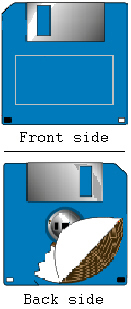Floppy disk
A floppy disk is a box with a disk inside. Its original function was a gambling game, where the prize was your data actually being stored accurately. The popularity of the floppy disk diminished once people realized that no one ever won this game. Meanwhile, smart people always bet against the floppy disk preserving creations, becoming rich enough to invent the flash drive.
History[edit]
In 1973, after much research by a team of 12 Welsh miners, IBM released the floppy disk. It was used to distribute software, transfer data between computers, and create small backups.
Before hard drives were invented, floppy disks also stored reliable operating systems unreliably. This trend faded with the introduction of Windows and Blue Screens of Death, in which the unreliability is incorporated into the operating system.
Other names[edit]
Floppy disks are also known as floppies, a name chosen to deter amateur computer enthusiasts in the late '70s, as computers were seen as industrial in nature and not for home use; and sometimes stiffies because of their rigid housing. The Chinese junior assistant who was present on all programming projects (yes, the code Coolie) referred to them as froppies.
Earlier versions[edit]
Floppy disks used to come in other sizes:
- The 8-inch version
- The 5¼-inch version.
Unlike modern floppy disks, these early versions were not stiffies but actually floppy. These floppy disks must be folded to fit in the slots of modern computers. Fortunately, doing so does not affect their reliability.
Storage capacity[edit]
During their introduction, the formatted capacity of the floppies was originally the round number (when expressed in binary) of 6.66 MB. For mass production, this value was changed to 1.44 MB (acquired by dividing 6660 by X) apparently because the manufacturers "got the willies" due to the number’s association with the Satan. This change suited IBM’s ultimate goal of covertly collecting users' information, as the unused 5.22 MB contained a pre-installed command line to capture keystrokes.[1]
Further evolution[edit]
In the late 1990s, Donkey Kong became the first computer program larger than 1.44 MB. This threw the computer industry into panic, and marketeers developed plans to convince users not to expect such complexity. One campaign, in which customers who wanted higher capacities were told to "Zip it up," resulted in a new variety of storage devices, and a system of American postal codes.
Eventually, 2.88 MB floppies were developed. There was just one problem: No one's computer could read them. (The suggestion that everyone discard their computers and buy all-new gear was not as persuasive back then as it has become today when someone invents something.)
Independently, however, swarthy foreigners were developing high-capacity media that were not floppy at all. They reflected light in pleasing colors, which is captivating when you are high, first CDs, then DVDs. Now, flash drives hold not only MB but GB and TB, though they just sit there like turds, they don't glitter, have no moving parts, and never give you challenging "bad sector" errors. Scientists are working to solve these problems and restore the tactile feedback and participation for drugged-out users that storage devices used to have in the days of the floppy, punched cards, and paper tape. In a few years, ultra-modern mass storage devices may again jam in the reader.
TV science-fiction tells us that, by the year 2250, interplanetary starships will stop using the higher-capacity media and revert to using floppy disks. Desks and tables will have a slot for floppies, along with a single, Radio-Shack-style pushbutton that does whatever you intended. However, users will refer to these floppies as "tapes." No one will worry about replacing all the furniture when something better comes along.
Reasons to use[edit]
- Its name contradicts itself.
- Its balky metal shutter ensures you won't drool on it, and gives you an excuse not to recycle it.
- It can be a Ninja star in a pinch (but the only person you are going to harm is you, by making your target mad).
- It may a splode for no reason at all.
- It can be taken apart and some pieces put back together as a model Starship Enterprise.[2]
- If you accumulate enough of them, they make a unique wallpaper.
- Reader experiment
Save your term paper to a floppy disk so that you can print it and hand it in at school. Then place a really strong magnet on the case and leave it overnight. You will be surprised at the results.
See also[edit]
References[edit]
- ↑ Declassified 1968 IBM action plan (Due to a government cover-up, this file has been stolen by the CIA.)
- ↑ Make a Starship Enterprise out of a floppy
| |||||||

